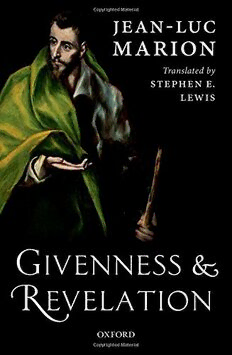
Givenness and revelation PDF
Preview Givenness and revelation
Givenness and Revelation Givenness and Revelation by JEAN-LUC MARION Translatedby STEPHEN E. LEWIS 1 3 GreatClarendonStreet,Oxford,OX26DP, UnitedKingdom OxfordUniversityPressisadepartmentoftheUniversityofOxford. ItfurtherstheUniversity’sobjectiveofexcellenceinresearch,scholarship, andeducationbypublishingworldwide.Oxfordisaregisteredtrademarkof OxfordUniversityPressintheUKandincertainothercountries ©Jean-LucMarionandStephenE.Lewis Themoralrightsoftheauthorshavebeenasserted FirstEditionpublishedin2016 Impression:1 Allrightsreserved.Nopartofthispublicationmaybereproduced,storedin aretrievalsystem,ortransmitted,inanyformorbyanymeans,withoutthe priorpermissioninwritingofOxfordUniversityPress,orasexpresslypermitted bylaw,bylicenceorundertermsagreedwiththeappropriatereprographics rightsorganization.Enquiriesconcerningreproductionoutsidethescopeofthe aboveshouldbesenttotheRightsDepartment,OxfordUniversityPress,atthe addressabove Youmustnotcirculatethisworkinanyotherform andyoumustimposethissameconditiononanyacquirer PublishedintheUnitedStatesofAmericabyOxfordUniversityPress 198MadisonAvenue,NewYork,NY10016,UnitedStatesofAmerica BritishLibraryCataloguinginPublicationData Dataavailable LibraryofCongressControlNumber:2015957371 ISBN 978–0–19–875773–3 PrintedinGreatBritainby ClaysLtd,StIvesplc LinkstothirdpartywebsitesareprovidedbyOxfordingoodfaithand forinformationonly.Oxforddisclaimsanyresponsibilityforthematerials containedinanythirdpartywebsitereferencedinthiswork Foreword fl Jean-Luc Marion: A Re ection Ramona Fotiade David Jasper Jean-Luc Marion’s Gifford Lectures, delivered at the University of Glasgow in 2014, represent both the unity and the deep continuity of his thinking over many decades. That unity finds its heart, per- haps,inthephenomenologicaltrilogyknowntotheEnglish-reading world as Reduction and Givenness, Being Given: Toward a Phenomenology of Givenness, and In Excess: Studies of Saturated Phenomena. A significant partofhisargumentationintherecentseriesoflecturesdrawsonthe re-definition of the notions of “possibility” and “impossibility”, the critique of the reification of the subject, and the unpredictability of the “event” in its relationship to the phenomenology of the gift which Jean-Luc Marion has elaborated in his recent work, Negative Certainties. Thescopeofthecurrentinvestigationintotheoriginsandevolution of “givenness” and “revelation” arises from an initial reappraisal of thetensionbetween“naturaltheology”andthe“revealedknowledge of God” or sacra doctrina. The preliminary review of the historical debates on the topic, encompassing the medieval period (Thomas Aquinas) and the “late scholasticism” of Francisco Suárez, brings to light the gradual “decoupling of revelation” from faith and the “sci- enceoftheblessed”,butalsothe“resistancetothisdrift”whichopens upthepossibility ofanon-propositional definition ofrevelation; that is, of a manner of conceiving revelation without imposing on it the epistemologicallimitationsthatKantianreasonsetstopossibleexperi- ence. This radical attempt at re-defining the bounds of speculative discourse (and re-shaping our understanding of what is considered impossibleforreason,butwhichdoesnotsimilarlylimitthepossibility oftheunthinkable,ofGod)extendstoJean-LucMarion’sengagement vi Foreword withphenomenology;inparticular,itunderlieshiscritiqueofthepre- conditionssetbytheHusserlianmethodologytothepossibilityofany- thing appearing or becoming manifest. Throughout the long list of bookswhichhavemarked,sincethepublicationofTheIdolandDistance, Jean-LucMarion’sconceptualreframingofthequestionofGodandhis re-configured“returntothethingsthemselves”throughthenotionsof “givenness”andofthe“gift”,theaimhasbeentoenhancenotonlyour understanding of religious experience, but to enlarge the horizon of possibilityofphenomenologyitself,astheauthorarguedinBeingGiven: Myentireprojecthasbeendirectedtoliberatingpossibilityinphenom- enality,tounbindingthephenomenonfromthesupposedequivalences thatlimititsdeployment(theobject,thebeing,common-lawadequation, povertyofintuition).1 In this context, the distinction between metaphysics (or “natural theology”) and “revealed theology” brings out the former’s inability to resist phenomenological reduction (insofar as it is based on tran- scendence, causality, substantiality, and actuality), whereas the latter displays an unexpected resilience due to its grounding in “facts whicharegivenpositivelyasfigures,appearances,andmanifestations (indeed, apparitions, miracles, revelations)”, so that it actually “takes placeinthenaturalfieldofphenomenalityandisthereforedependent onthecompetenceofphenomenology”.2Fromthisperspective,when the question of the “forbidden” application of phenomenology to religionisraised,inlightoftheundeniableexclusionofalltranscend- ence by reduction, Jean-Luc Marion provides an answer which cuts rightthroughtotheheartofthedebatebetweenepistemologicaland revealedknowledge,inpointingattheoriginalaspirationofphenom- enology to become “the science of true principles, of the sources, of theριζώματαπάντων[therootsofallthings]”,accordingtoHusserl3 1 Jean-LucMarion,BeingGiven:TowardaPhenomenologyofGiveness,trans.Jeffrey L. Kosky (Stanford, California: Stanford University Press, 2002, new preface 2013),p.234. 2 Jean-LucMarion,InExcess:StudiesofSaturatedPhenomena,trans.RobynHorner andVincentBerraud(NewYork:FordhamUniversityPress,2002),p.28. 3 EdmundHusserl,“PhilosophyasRigorousScience,”inPhenomenologyandthe Crisis of Philosophy, trans. Quentin Lauer (New York: Harper and Row, 1965), p.146. Foreword vii This aspiration in itself is no different from the historical aim of metaphysics and of the “sacred doctrine” itself, although it is appar- entlydrivenbytheneedtoprovidenewgroundingfor“philosophyas rigorous science” beyond the realm of theology and “revealed sci- ence”. Some of the earliest commentators of Husserl in France alreadypointedout this striking,ifunintended, coincidence between theaimsoftheologyandthoseofphenomenology:“Whenamodern scientistspeaksofprinciples,oftherootsofthings,itisobviouslyGod that he has in mind, but a God whose existence he places outside of everytheologicalorevenmetaphysicalsystem.”4 It is not surprising then to find, in more recent times, a similar reminderoftheinherentpredispositionoftheHusserlianprojectin Jean-Luc Marion’s response to the critics of the so-called “theo- logical turn” in phenomenology: “If phenomenology could ‘turn’ to theology...this turning itself would remain impossible without somephenomenologicalpredisposition.”5Andthis“predisposition” resides in Husserl’s decisive attempt at clearing a path toward the thingsthemselves,despiteKantianprohibitions,andinkeepingnot so much with the principle of a strict correlation between significa- tionandsensibleintuition,butwiththenotionof“givenness”assuch, which“precedesintuitionandabolishesitsKantianlimits”,asJean-Luc MarionarguedinTheVisibleandtheRevealed: Toreturntothethingsthemselvesamountstorecognizingphenomena asthemselves,withoutsubmittingthemtothe(sufficient)conditionof ananteriorauthority(suchasthinginitself,cause,principle,etc.).In short,itmeansliberatingthemfromanyprerequisiteotherthantheir simple givenness, to which consciousness bears witness before any constitution.6 Thereforethequestionisnolongerthatofdeterminingthelegitimacy ofaphenomenologicalreadingoftheeventsofrevelation,butthatof the possibility of a mutual enhancement of two complementary, 4 LevShestov,“MementoMori.Husserl’sPhilosophy”,inPotestasClavium,trans. BernardMartin(Athens,Ohio:OhioUniversityPress,1968),p.298. 5 Marion,InExcess,p.27. 6 Jean-LucMarion,TheVisibleandtheRevealed,trans.ChristinaM.Gschwandtner (FordhamUniversityPress,2008),p.5. viii Foreword though seemingly incompatible, fields of enquiry: “Can phenomen- ologycontributeinaprivilegedwaytothedevelopmentofa‘philoso- phyofreligion’?Inotherwords,can‘philosophyofreligion’becomea ‘phenomenology of religion’?”7 From the outset, this type of investi- gationaimstoproblematizetheconceptofgivennessitself,ratherthan theeffectsofphenomenologicalreduction.8Enlargingthehorizonof phenomenality and suspending the Kantian presupposition of the constitutingtranscendental“I”thusarisefromtheneedtoovercome methodologicallimitationswhichotherwiseexclude“fromthefieldof manifestation not only many phenomena, but above all those most endowedwithmeaningandthosethataremostpowerful”.9Anditis inlightofthisnew,radicalunderstandingofmanifestationas“satur- ated phenomenon” that Jean-Luc Marion believes “only a phenom- enologyofgivennesscanreturntothethingsthemselves”.10 Oneoftheadvantagesofthisdecisivemovebeyondtheframework of intentional constitution is that it allows for a range of paradoxical notionsandcontradictoryrelationshipstoemergewithinaphilosoph- ical discourse whose fundamental principles for truthful reasoning seemed designed to exclude any alternative epistemological model, not grounded in evident certitude and reason. This enables, for instance,Jean-LucMariontopointoutthat,whereas“aphenomenon onlyshowsitselftotheextentthatitfirstgivesitself....[T]hereverseis not the same: all that which gives itself does not show itself necessar- ily”.11 Revelation, as the overarching saturated phenomenon, which encompassesthefourothertypesofsaturatedphenomena(theevent, the idol, the flesh, and the icon), pertains to a unique regime of manifestationwhichrequiresthe“anamorphosis”or“theconversion ofthegaze”ofthesubjectbeforethesubjectcanseeandunderstand that which gives itself as mysteˉrion, as hidden. And the elegant inter- pretationoftheinterplayofinvisibilityandmanifestation,hearingand seeing in Caravaggio’s The Calling of St. Matthew in the final part of Being Given similarly bears witness to the double paradox of a 7 Marion,TheVisibleandtheRevealed,p.1. 8 Marion,InExcess,p.29. 9 Marion,BeingGiven,p.4. 10 Marion,BeingGiven,p.4. 11 Marion,InExcess,p.30. Foreword ix phenomenality of the audible rendered visible, and of a call which “gives itself phenomenologically only by first showing itself in a response”.12 It is notonly the artist who “must show in silence acall that is invisible”,13 it is first and foremost the viewer through the intermediary of Saint Matthew, as the intended recipient of the call, whoultimatelyrenderstheinvisiblemanifestbyliftinghiseyestocross thegazesoftwocharactersstandingbythewindow(ChristandSaint Peter),justashepointsathimselfwithhislefthand,inresponsetothe complexwebofvisualsignals(fromtherayoflighttothegazeandthe gestureofthetwocharacters)whichsinglehimout.Theconversionor the “anamorphosis” of the gaze is accomplished by a surprising overturning of the relationship between truth and “belief grounded inreason”,whichJean-LucMarionexemplifiesinhissecondGifford Lecture with reference to William of Saint-Thierry’s assertion, according to which “it is not so much the reason that draws the will [towardtheevidence],asthewillthatdrawsthereasontowardfaith”. ItisperhapsintheexampleofTheCallingofSt.Matthewthat onecan best grasp the paradox of an “impossible” convergence between the uncoveringoftruthwhichnaturaltheologycanhopetoattainhereand now,invia,andtheeschatologicalmeaningofrevelationasapokalypsis. Thecall,aspre-eminentevent,displaystheirreducibleaporiaofreve- lation and of Christ as saturated phenomena: both historical and abstractedfromtime,bothgivenandunseen,excessive,like“thehyper- bolicloveofChristwhichsurpassesknowledge”,andwhichrequiresan “epistemological break...according to the place of listening” which allowsthedisciples“tobeintherightplace,wherehearingmayhappen” (LectureThree).Ultimately,revelation“doesnotbelongtohistory..., butisregisteredin,orratherthrough,events,i.e.saturatedphenomena, which are not objectifiable by concepts”, and the coming of which requiresacompletetransformationofthehumangazethatplacesthe witness“attheprecisepointwhere(likeatwo-dimensionalimagethat, under aprecise angleofviewwiththelightreflected,justsosuddenly makesthethirddimensionspringforth)”theiconicmodeloftheTrinity isrenderedmanifest(LectureFour). 12 Marion,BeingGiven,p.285. 13 Marion,BeingGiven,p.283.
